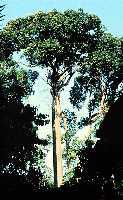View crop
View crop Data sheet EcoPortBertholletia excelsa
 |
|
| Notes |
|---|
| BRIEF DESCRIPTION A medium sized to large tree reaching a height of 25-56 m, with a trunk diameter of up to 1-2 m. It is usually only branched in the upper part. It has large leaves 25-50 cm long and large, light-yellow flowers. The ripe fruit contains 12-24 angular brown seeds. USES The seeds or nuts are consumed as food or extracted for oil. The first oil extract is used as cooking oil, while the second is suitable for soap-making and as an illuminant. The seed cakes can be used to fed livestock. The capsule can be used as fuel. The timber is of excellent quality. GROWING PERIOD Perennial. The tree begins to flower in its 5th or 6th year, it begins to bear fruit when it is 10-20 years old, and the fruit take about one year to ripen. Blossoms and mature fruits can be found on the tree at the same time. Flowering usually takes place from October to March and harvest season is from late November to early June. COMMON NAMES Brazil nut, Para nut, Cream nut, butter nut, Nigger toe, Noix du Bresil, Chatagne du Brasile, Noce del Brasile, Nuez del Brasil, Noyer du Bresil, Nuez de Para, Amande d'Amerique, Noix d'Amerique, Noix du Bresil, Castana del Para, Noix de Para, Pavory nut, Para nut, Brasilianishe kastanien, Paranuss, Almendron, Castano, Jubia, Juvia, Castanha do Moranhao, Castanha do Brasil, Castanha do Para, Arai, Inia, nha, nia,Tcai, Tuca tucari, Ya, Invia, Touca. FURTHER INF Scientific synonym: B. nobilisis, B. myrtaceae. Brazil nut is probably native of the southeastern Amazon region in South America. It can be grown at low altitudes in the tropics and are adapted to growing in areas of high relative humidity about 79-86%. Young trees needs shading until 5-7 years old. Mentioned as a useful agroforestry species. High yielding mature trees may produce 200-400 fruits yielding 100-120 kg unshelled seeds (commercial nuts). Harvesting can be a hazardous operation and usually starts after most of the fruits have fallen because of the danger of being hit by the 500-750 g heavy fruits falling from heights of up to 55 m. | Sources |
| SOURCES (B. excelsa Humb. & Bonpl.) Williams C 1979a pp 118-119 [TEMP, RAIN, DRA, FER, TEXT] Roecklein J 1987 pp 322 [USE] Purseglove J 1974 pp 637 [USE] Lotschert W 1983 pp 196 Woodroof J 1979 pp 181-218 [TEMP, DRA, TEXT] Nair P 1984 pp 18 [PH, FER, USE] Williams C 1982 Fouque A 1972 Samson J 1991 pp 284 FAO For. Paper 77 pp 145 Martin F 1984 pp 249-250 [TEMP, RAIN, PHO, DRA, DEP, USE] Verheij E 1991 pp 321 [USE] Wickens G 1995 pp 28-33 [USE, RAIN, TEMP, DEP, DRA, TEXT] |